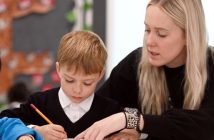For our new column, Ask an Educator, we turn to educators, whether teachers, tutors, or principals, to answer frequently asked questions from parents. To send in your question, email jessicasuotmaa@beijing-kids.com.
Answering for us is Amy Luczak, Grade Six English Lead Teacher at Daystar Academy.
This week’s question is:
“What is the Columbia Reading and Writing Project and how is it different from other programs in practice?”
“I actually had the wonderful opportunity to attend one of their summer reading institutes last year, and will be returning this summer again, so I’m very happy to explain this a bit for families in Beijing, who may have heard of this program but aren’t exactly sure what it’s all about.”

The Teacher’s College Reading and Writing Project (TCRWP) is a think tank of educators who work with research, curriculum development and partnerships with many schools in the US and around the world with the goal of helping young students become proficient readers, writers and inquirers. The program itself (or curriculum) that schools are now using, was piloted out of the Teacher’s College at Columbia University. The Teacher’s College serves as the graduate school for health, psychology and education majors for Columbia University.
Specifically, the project was spearheaded by a woman named Lucy Calkins and several of her colleagues more than thirty years ago. They researched and studied how published writers wrote, what the process was that they went through, and then they developed classroom lessons to simulate this process with students. Initially their focus was on writing, but it soon spread to the teaching of reading as well.
The curriculum itself uses the American Common Core Standards, and it uses a basic “workshop” model of teaching. TCRWP didn’t by any means create the workshop model, as it’s been a teaching practice for many years and across multiple subjects. The workshop model is one where the teacher gives a short “mini-lesson” usually through direct instruction of a new skill, and then allows the majority of the remaining time for students to independently practice this skill, receiving feedback from the teacher through conferencing and small group work. The goal of the workshop model is to minimize teacher lecture time and maximize students’ practice time. The Reading and Writing Project uses their past and continued research as well as best teaching practices to create these lessons, and they are delivered through the workshop model.
As a teacher, I think there are many things about TCRWP’s curriculum which are great. Here are a few of the big ones:
• Leveled Reading – One of the most common confusions from parents at first that I’ve seen is that the students don’t use a whole class “reading book”. This is different than how many of us grew up reading, where every student in the class has the same reading book and takes turns reading in a round robin or other similar style. The reality in classrooms is that students are always going to be at different levels. TCRWP uses A-Z leveled readers (based on the Fountas and Pinnell system), so students read at their own independent level. When parents ask me, “Where are their reading books?” I have to explain that we don’t have reading books, we just read books. Students usually have individual book boxes that they use to keep their independent reading books from our classroom library.
• Authenticity and choice – Students are readers and writers, and they are treated this way. By allowing the children to choose which books they will read (from a leveled tub of books) or topics they will write about within a genre of writing, they become more engaged in their own learning. They start to see the usefulness of learning to read and write, and how it applies to their lives. They become readers and writers.
• Differentiation – One of the biggest challenges teachers face is how to differentiate their instruction, to reach a group of diverse students at their individual levels. The leveled reading system allows for this, and the workshop model is structured so that during independent practice time teachers can do individual and small group work with students to address their different needs. This time can be used to give a guided reading lesson, a skill or strategy group lesson, or for remedial lessons for students who need re-teaching. Whether a child is below grade level or above grade level, each child benefits from what is being taught because the instruction is at their level.
Just to clarify, many other programs use some of these same great aspects. What makes TCRWP different is that it incorporates so many of the common best practices of teaching, which in turn creates high student engagement and ultimately high achievement.
Photo: courtesy of Amy Luczak




